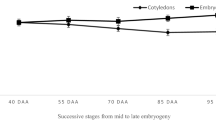Abstract
A study was conducted to determine the physiological characteristics changes of Aesculus chinensis seeds during natural dehydration in 2003. The results showed that A. chinensis seeds were recalcitrant with being highly desiccation-sensitive. The seed moisture content of fresh fruits was higher than 60%. When the seeds were naturally dried for 30 days, their moisture content declined to 30.2% and their viability was completely lost. The seed germination percentage had a small increase at the beginning of desiccation and then decreased rapidly. The relative electrical conductivity of the A. chinensis seeds increased along with a decrease in seed moisture content. However, there was an abnormal increase in relative electrical conductivity when the seed moisture content was between 53.7% and 50.9%. Superoxide dismutase (SOD) activity decreased rapidly in the period of desiccation except for an abnormality when the seed moisture content was between 53.7% and 50.9%. Malondialdehyde (MDA) content increased slowly at the early stage of desiccation and then rose rapidly after the moisture content was below 50.9%. The soluble sugar content in seeds slowly increased with the increasing period of desiccation. The seed germination percentage was at the high level when seed moisture content was in range of 47%–60%, which suggests that this was the optimum moisture content for maintaining A. chinensis seed viability.
Similar content being viewed by others
References
Becwar, M.R., Stanwood, P.C. and Roos, E.E. 1982. Dehydration effects on imbibitional leakage from desiccation-sensitive seeds [J]. Plant physiology, 69: 1132–1135.
Chabrillange, N., Dussert, S., Engelmann, F., et al. 2000. Desiccation tolerance in relation to soluble sugar contents in seeds of ten coffee (Coffea L.) species [J]. Seed Science Research. 10: 393–396.
Chaitanya, K.S.K. and Naithani, S.C. 1994. Role of superoxide, lipid peroxidation and superoxide dismutase in membrane perturbation during loss of viability in seeds of Shorea robusta Gaertn [J]. New Phytologist. 126: 623–627.
Chen Junsong, Chen Runzheng and Fu Jiarui. 1998. Germination character of Loquat (Eriobotrya japonica) seed [J]. Seed, 99(6): 3–6. (in Chinese)
Connor, K.F. and Sowa S. 2003. Effects of desiccation on the physiology and biochemistry of Quercus alba acorns [J]. Tree Physiology, 23: 1147–1152.
Finch-Savage, W.E., Blake, P.S. and Clay, H.A. 1996. Desiccation stress in recalcitrant Quercus robur L. seeds results in lipid peroxidation and increased synthesis of jasmonates and abscisic acid [J]. Journal of Experimental Botany. 47: 661–667.
Hendry, G.A.F., Finch-Savage, W.F., Thorpe, P.C., et al. 1992. Free radical processes and loss of seed viability during desiccation in the recalcitrant species Quercus robur L [J]. New Phytologist. 122: 273–279.
Li, C. and Sun, W.Q. 1999. Desiccation sensitivity and activities of free radical-scavenging enzymes in recalcitrant Theobroma cacao seeds [J]. Seed Science Research, 9: 209–217.
Lin, T.P. and M.H. Chen 1995. Biochemical characteristics associated with the development of desiccation-sensitive seeds of Machilus thunbergii Sieb. And Zucc [J]. Annals of Botany, 76: 381–187.
Pammenter, N.W. and Berjak, P. 1999. A review of recalcitrant seed physiology in relation to desiccation tolerance mechanisms [J]. Seed Science Research, 9: 13–37.
Roberts, E.H. 1973. Predicting the storage life of seeds [J]. Seed Science and Technology, 1: 499–514.
SFA General Administration of Forest Farms, Tree Seeds and Seedlings. 2001. Seeds of Woody Plants in China [M]. Beijing: China Forestry Publishing House, p895–897. (in Chinese)
Zhao Qi. 1995. Experimental guide of plant physiology and biochemistry [M]. Beijing: China Agriculture Press, 97–99. (in Chinese)
Author information
Authors and Affiliations
Additional information
Biography: YU Fang-yuan (1965–), male, associate professor in Tree Seed Center, College of Forest Resources and Environment, Nanjing Forestry University, Nanjing 210037, P. R. China
Rights and permissions
About this article
Cite this article
Yu, Fy., Du, Y. & Shen, Yb. Physiological characteristics changes of Aesculus chinensis seeds during natural dehydration. J. of For. Res. 17, 103–106 (2006). https://doi.org/10.1007/s11676-006-0024-2
Received:
Accepted:
Issue Date:
DOI: https://doi.org/10.1007/s11676-006-0024-2
Keywords
- Aesculus chinensis
- Seeds
- Air drying
- Physiological characteristics
- Seed moisture content
- Seed germination percentage
- Superoxide dismutase (SOD) activity
- Malondialdehyde (MDA) content
- Seed electrical conductivity




